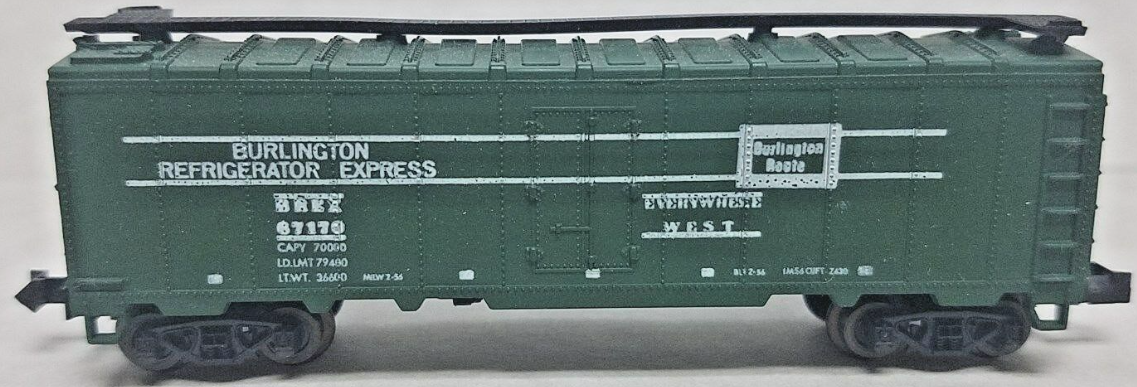I will
combine multi-purchases into one package. IF YOU WANT CREDIT FOR SAVINGS
ON SHIPPING FROM COMBINE PURCHASES Don’t use phone apt because it
automatically pays for item and shipping! Payment precludes saving on
shipping. USE A DESK OR LAPTOP COMPUTER! Buy, BUT DO NOT
PAY! When you are through buying, message me and ask for invoice.
N Scale - Minitrix - 3246 - Reefer, Ice, Steel - Burlington Route - 67170

Stock Number 3246
Brand Minitrix
Manufacturer Roco
Body Style Roco Reefer 40 Foot Steel
Prototype Vehicle Reefer, Ice, Steel (Details)
Road or Company Name Burlington Route (Details)
Reporting Marks BNEX
Road or Reporting Number 67170
Paint Color(s) Green
Print Color(s) White
Coupler Type Rapido Hook
Wheel Type Chemically Blackened Metal
Wheel Profile Deep Flange
Release Date 1970-01-01
Item Category Rolling Stock (Freight)
Model Type Reefer
Model Subtype 40 Foot
Model Variety Steel
Prototype Region North America
Prototype Era NA Era III: Transition (1939 - 1957)
Scale 1/160
Track Gauge N standard
Model Information: Produced by Roco and imported by Minitrix and others, this 40 Foot Steel Reefer was released in the early 1970s. These cars feature some of the worst performing trucks I have encountered. They do not roll well at all.
Prototype History: Not all steel reefers contained mechanical refrigeration units. Although today we expect that a modern reefer contain an air conditioning unit to be integral to the car design, this was not always true. There was a period following the second world war when the cost of steel was cheap but the cost of a refrigeration unit was high. Early mechanical refrigeration units were unreliable, noisy, expensive and costly to maintain, and for the early post-war years many railroads continued to use ice for refrigeration even though the technology for mechanical refrigeration was possible.
In the post-WWII period, steel once again became readily available and the railroads rapidly replaced their aging fleets of wood reefers with newly constructed steel cars. Among the more common steel reefers for meat and other perishable commodities were those built by URTX. These cars had a horizontal rivet strip along the middle of each side, improved Dreadnaught ends and diagonal-panel roofs.
From Wikipedia and other sources
Road Name History: The Chicago, Burlington and Quincy Railroad (reporting mark CBQ) was a railroad that operated in the Midwestern United States. Commonly referred to as the Burlington or as the Q, the Burlington Route served a large area, including extensive trackage in the states of Colorado, Illinois, Iowa, Kentucky, Missouri, Montana, Nebraska, Wisconsin, Wyoming, and also in New Mexico and Texas through subsidiaries Colorado and Southern Railway, Fort Worth and Denver Railway, and Burlington-Rock Island Railroad.[citation needed] Its primary connections included Chicago, Minneapolis-St. Paul, St. Louis, Kansas City and Denver. Because of this extensive trackage in the midwest and mountain states, the railroad used the advertising slogans "Everywhere West", "Way of the Zephyrs", and "The Way West". It merged into Burlington Northern in 1970.
In 1967, it reported 19,565 million net ton-miles of revenue freight and 723 million passenger miles; corresponding totals for C&S were 1,100 and 10 and for FW&D were 1,466 and 13. At the end of the year CB&Q operated 8,538 route-miles, C&S operated 708 and FW&D operated 1362. (These totals may or may not include the former Burlington-Rock Island Railroad.)